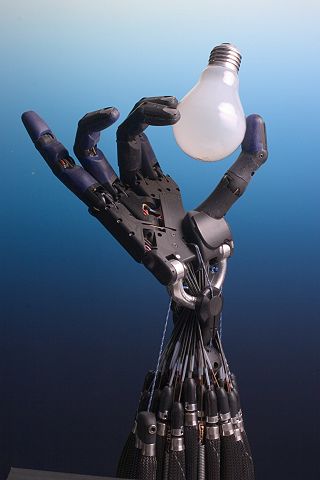Related Research Articles
An autonomous robot is a robot that acts without recourse to human control. Historic examples include space probes. Modern examples include self-driving vacuums and cars.

A humanoid robot is a robot resembling the human body in shape. The design may be for functional purposes, such as interacting with human tools and environments, for experimental purposes, such as the study of bipedal locomotion, or for other purposes. In general, humanoid robots have a torso, a head, two arms, and two legs, though some humanoid robots may replicate only part of the body, for example, from the waist up. Some humanoid robots also have heads designed to replicate human facial features such as eyes and mouths. Androids are humanoid robots built to aesthetically resemble humans.

Swarm robotics is an approach to the coordination of multiple robots as a system which consist of large numbers of mostly simple physical robots. ″In a robot swarm, the collective behavior of the robots results from local interactions between the robots and between the robots and the environment in which they act.″ It is supposed that a desired collective behavior emerges from the interactions between the robots and interactions of robots with the environment. This approach emerged on the field of artificial swarm intelligence, as well as the biological studies of insects, ants and other fields in nature, where swarm behaviour occurs.

Crowne Plaza is a British-American multinational chain of full service, upscale hotels headquartered in the United Kingdom. It caters to the business, leisure and blended travel market usually located in city centers, resorts, coastal towns or near major airports. The brand is part of IHG Hotels & Resorts family of brands, which include InterContinental Hotels & Resorts and Holiday Inn Hotels & Resorts, and operates in nearly 100 countries with more than 400 hotels and 110,000 bedrooms,

An autonomous underwater vehicle (AUV) is a robot that travels underwater without requiring continuous input from an operator. AUVs constitute part of a larger group of undersea systems known as unmanned underwater vehicles, a classification that includes non-autonomous remotely operated underwater vehicles (ROVs) – controlled and powered from the surface by an operator/pilot via an umbilical or using remote control. In military applications an AUV is more often referred to as an unmanned undersea vehicle (UUV). Underwater gliders are a subclass of AUVs.

An unmanned ground vehicle (UGV) is a vehicle that operates while in contact with the ground without an onboard human presence. UGVs can be used for many applications where it is inconvenient, dangerous, expensive, or impossible to use an onboard human operator. Typically, the vehicle has sensors to observe the environment, and autonomously controls its behavior or uses a remote human operator to control the vehicle via teleoperation.

An underwater glider is a type of autonomous underwater vehicle (AUV) that employs variable-buoyancy propulsion instead of traditional propellers or thrusters. It employs variable buoyancy in a similar way to a profiling float, but unlike a float, which can move only up and down, an underwater glider is fitted with hydrofoils that allow it to glide forward while descending through the water. At a certain depth, the glider switches to positive buoyancy to climb back up and forward, and the cycle is then repeated.

A medical robot is a robot used in the medical sciences. They include surgical robots. These are in most telemanipulators, which use the surgeon's activators on one side to control the "effector" on the other side.

A mobile robot is an automatic machine that is capable of locomotion. Mobile robotics is usually considered to be a subfield of robotics and information engineering.

A robot competition is an event where the abilities and characteristics of robots may be tested and assessed. Usually they have to outperform other robots in order to win the competition. Many competitions are for schools but several competitions with professional and hobbyist participants also exist.

A delivery robot is an autonomous robot that provides "last mile" delivery services. An operator may monitor and take control of the robot remotely in certain situations that the robot cannot resolve by itself such as when it is stuck in an obstacle. Delivery robots can be used in different settings such as food delivery, package delivery, hospital delivery, and room service.
ConGlomeration was an annual multigenre convention held in or around Louisville, Kentucky, between 2001 and 2019. ConGlomeration was an all-volunteer non-profit organization which, as part of its convention programming, conducted charitable activities on behalf of the American Cancer Society and Cabbage Patch Settlement House. With the unexpected closure of the convention's hotel in 2008, the operation of the convention was disrupted, but resumed in 2010. The final ConGlomeration, ConGlomeration 2020, was scheduled to be held at the Crowne Plaza Hotel in Louisville on Easter weekend, April 10–12, 2020, but was cancelled due to COVID-19.

Daniela L. Rus is a roboticist and computer scientist, Director of the MIT Computer Science and Artificial Intelligence Laboratory (CSAIL), and the Andrew and Erna Viterbi Professor in the Department of Electrical Engineering and Computer Science (EECS) at the Massachusetts Institute of Technology. She is the author of the books Computing the Future and The Heart and the Chip.

Robotics is the interdisciplinary study and practice of the design, construction, operation, and use of robots.
Mobile industrial robots are pieces of machinery that are able to be programmed to perform tasks in an industrial setting. Typically these have been used in stationary and workbench applications; however, mobile industrial robots introduce a new method for lean manufacturing. With advances in controls and robotics, current technology has been improved allowing for mobile tasks such as product delivery. This additional flexibility in manufacturing can save a company time and money during the manufacturing process, and therefore results in a cheaper end product.
Hanson Robotics Limited is a Hong Kong-based engineering and robotics company founded by David Hanson, known for its development of human-like robots with artificial intelligence (AI) for consumer, entertainment, service, healthcare, and research applications. The robots include Albert HUBO, the first walking robot with human-like expressions; BINA48, an interactive humanoid robot bust; and Sophia, the world's first robot citizen. The company has 45 employees.
A companion robot is a robot created to create real or apparent companionship for human beings. Target markets for companion robots include the elderly and single children. Companions robots are expected to communicate with non-experts in a natural and intuitive way. They offer a variety of functions, such as monitoring the home remotely, communicating with people, or waking people up in the morning. Their aim is to perform a wide array of tasks including educational functions, home security, diary duties, entertainment and message delivery services, etc.
A four-dimensional product considers a physical product as a life-like entity capable of changing form and physical properties autonomously over time. It is an evolving field of product design practice and research linked to similar concepts at the material scale, however, typically utilizes sensors and actuators in order to respond to environmental and human conditions, modifying the shape, color, character and other physical properties of the product. In this way 4D products share similarities with responsive architecture, at the more human scale associated with products.

Yandex self-driving car is an autonomous car project of the Russian-based technology company Yandex. The first driverless prototype launched in May 2017. As of 2018, functional service was launched in Russia with prototypes also being tested in Israel and the United States. In 2019, Yandex revealed autonomous delivery robots based on the same technology stack as the company's self-driving cars. Since 2020, autonomous robots have been delivering food, groceries and parcels in Russia and the United States. In 2020, the self-driving project was spun-off into a standalone company under the name of Yandex Self-Driving Group.

Margarita Chli is an assistant professor and leader of the Vision for Robotics Lab at ETH Zürich in Switzerland. Chli is a leader in the field of computer vision and robotics and was on the team of researchers to develop the first fully autonomous helicopter with onboard localization and mapping. Chli is also the Vice Director of the Institute of Robotics and Intelligent Systems and an Honorary Fellow of the University of Edinburgh in the United Kingdom. Her research currently focuses on developing visual perception and intelligence in flying autonomous robotic systems.
References
- 1 2 Falconer, Jason (October 29, 2013). "HOSPI-R drug delivery robot frees nurses to do more important work". newatlas.com. Retrieved 2018-11-26.
- 1 2 Szondy, David (January 16, 2017). "Panasonic robots take temp jobs at airport and hotel". newatlas.com. Retrieved 2018-11-26.
- ↑ "Panasonic Revives Hospital Delivery Robot". IEEE Spectrum . IEEE Spectrum. May 15, 2014. Retrieved October 4, 2014.
- ↑ Crowe, Steve (20 January 2017). "Hospi Delivery Robot Being Tested at Airport, Hotel - Robotics Trends". www.roboticstrends.com. Retrieved 2017-09-20.
- ↑ "Panasonic Hospi Is a Robot Helper For Hotels - Geek.com". Geek.com. 2017-01-18. Archived from the original on 2017-09-20. Retrieved 2017-09-20.
- ↑ "Panasonic's hospitality robot is serving drinks and clearing tables in Japan". Recode. Retrieved 2017-09-20.
- ↑ FINANCIAL, The (18 January 2018). "Panasonic Conducts Demonstration Experiment of Autonomous Signage Robot, "HOSPI(R)" at Narita Airport". www.finchannel.com. Retrieved 2018-11-26.